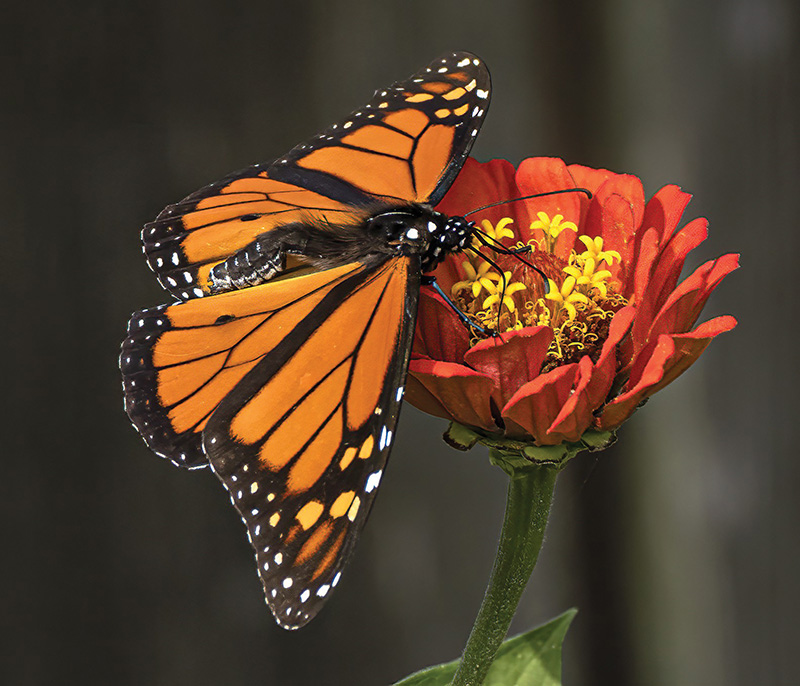
Here Come the Monarchs

Monarch butterfly. Image credit: Ingrid Feddersen.
Each fall, as we all know, tens of thousands of monarch butterflies (Danaus plexippus) fly from the Northeast to the central mountains of Mexico, where they huddle together and overwinter with other monarchs from across the country.
It’s a staggering 3,000-mile trip—the second longest migration of all known insects, rivaled only by dragonflies, who fly nonstop across the Indian Ocean—that takes these butterflies roughly two months to complete, and scientists are still perplexed about how they do it.
In fact, when I asked Dr. Kelsey Fisher, an entomologist with the Connecticut Agricultural Experiment Station (CAES) in New Haven how monarch butterflies navigate, she admitted, “That’s still a little bit unknown.”
However, she added, “There is some evidence that they use the sun angle and polarized light.” That is, when the sun reaches a certain height in the sky, it tells the butterflies when to fly.
It’s also believed monarchs, who fly only during the day, use visual cues, like mountain ranges or bodies of water, and a magnetic compass to help them navigate, Fisher said.
How do monarchs see and smell?
“Their vision is not the greatest,” Fisher explained. “They don’t have the fine resolution like we have. But I think what is more important is their antennae. That’s how they pick up the chemical signals from the air,” which helps these unique insects find nectar resources and fuel their migration.
Fisher said each year it takes three generations of monarchs, morphing from egg to caterpillar to chrysalis to butterfly, to make it up to the Northeast, and a fourth to fly back to Mexico.
The first three generations only live 6–8 weeks, lay their eggs, and die.
But Fisher points out that the fourth generation of monarch butterflies are the exceptional ones. These “mighty” monarchs, as she calls them, live the longest (September–May) and fly all the way to Mexico.
Not only that, but in late February, Fisher said these same monarchs “wake up” from their hibernation, fly around, mate, and head north, reaching Texas or Oklahoma roughly by early May to lay their precious eggs, which will eventually become the first of four generations of monarchs to complete the remarkable roundtrip journey.
Sadly, these beautiful butterflies are in decline. How do we know that?
Fisher said scientists have measured the forested areas where the monarchs overwinter in hectares (one hectare = 2.47 acres) for the past thirty years, and the numbers, especially in the last four years, have been dropping.
For instance, from 1994–2022, the season average was 5.23 hectares, and from 2004–2022, the season average was 3.26 hectares, a drop of almost two hectares, or five acres less of wintering monarchs.
What’s causing the decline?
A variety of reasons. But Fisher said pesticides and dwindling numbers of milkweed plants—on which female monarchs need to lay their eggs—seem to be two of the most pressing problems.
Fisher spent six years in Iowa (a state that is 97 percent agricultural) studying monarch movements with other scientists. During her stay, she made the following recommendations to Iowa’s Department of Transportation and many private landowners: “If we can plant more [nectar-rich] habitat patches 50 meters or less apart in agricultural landscapes, this may facilitate efficient monarch movement” and ultimately help the female monarchs lay more eggs.
“More eggs equal more caterpillars. More caterpillars equal more butterflies, and more butterflies means more overwintering populations in Central Mexico,” Fisher advocated.
Fisher had one more suggestion—for all of us: If you plant milkweed plants in your backyard, make sure that you plant more than one plant. Why?
Because once the monarch caterpillar hatches on that host plant and begins eating the leaves, within a week or less, it will want to find another milkweed plant. And if it cannot find another, Fisher said there’s a good chance it will die.
Dr. Fisher joined the CAES team in January 2023, and no doubt will be a great asset to the monarchs, and to all of us.
Bill Hobbs is a contributing nature writer for Estuary magazine and The Times newspaper in New London, CT. He welcomes all inquiries and can be reached at whobbs246@gmail.com.
